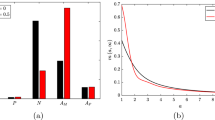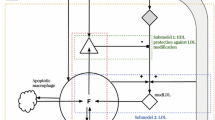Abstract
We present an ODE model which we use to investigate how High Density Lipoproteins (HDL) reduce the inflammatory response in atherosclerosis. HDL causes atherosclerotic plaque stabilisation and regression, and is an important potential marker and prevention target for cardiovascular disease. HDL enables cholesterol efflux from the arterial wall, macrophage and foam cell emigration, and has other athero-protective effects. Our basic inflammatory model is augmented to include several different ways that HDL can act in early atherosclerosis. In each case, the action of HDL is represented via a parameter in the model. The long-term model behaviour is investigated through phase plane analysis and simulations. Our results indicate that only HDL-enabled cholesterol efflux can stabilise the internalised lipid content in the lesion so that it does not continue to grow, but this does not reduce macrophage numbers which is required to stabilise the lesion or prevent rupture. HDL-enabled macrophage emigration guarantees lesion stabilisation by maintaining stable macrophage content.










Similar content being viewed by others
References
Aicher, B. O., Haser, E. K., Freeman, L. A., Carnie, A. V., Stonik, J. A., Wang, X., Remaley, A. T., Kato, G. J., & Canon, R. O. III (2012). Diet-induced weight loss in overweight or obese women and changes in high-density lipoprotein levels and function. Obesity, 20(10), 2057–2062.
Ameli, S., Hultgardh-Nilsson, A., Cercek, B., Shah, P. K., Forrester, J. S., Ageland, H., & Nilsson, J. (1994). Recombinant apolipoprotein A-I Milano reduces intimal thickening after balloon injury in hypercholesterolemic rabbits. Circulation, 90(4), 1935–1941.
Barter, P. J., Nicholls, S., Rye, K.-A., Anantharamaiah, G., Navab, M., & Fogelman, A. M. (2004). Anti-inflammatory properties of HDL. Circ. Res., 95(8), 764–772.
Berrougui, H., Isabelle, M., Cloutier, M., Grenier, G., & Khalil, A. (2007). Age-related impairment of HDL-mediated cholesterol efflux. J. Lipid Res., 48(2), 328–336.
Cobbold, C. A., Sherratt, J. A., & Maxwell, S. R. J. (2002). Lipoprotein oxidation and its significance for atherosclerosis: a mathematical approach. Bull. Math. Biol., 64, 65–95.
Dansky, H. M., & Fisher, E. A. (1999). High-density lipoprotein and plaque regression: the good cholesterol gets even better. Circulation, 100(17), 1762–1763.
Duffy, D., & Rader, D. J. (2006). Emerging therapies targeting high-density lipoprotein metabolism and reverse cholesterol transport. Circulation, 113(8), 1140–1150.
Ellison, R. C., Zhang, Y., Qureshi, M. M., Knox, S., Arnett, D. K., & Province, M. A. (2004). Lifestyle determinants of high-density lipoprotein cholesterol: the National Heart, Lung, and Blood Institute Family Heart Study. Am. Heart J., 147(3), 529–535.
Eriksson, M., Carlson, L. A., Miettinen, T. A., & Angelin, B. (1999). Stimulation of fecal steroid excretion after infusion of recombinant proapolipoprotein A-I. Circulation, 100(6), 594–598.
Feig, J. E., Rong, J. X., Shamir, R., Sanson, M., Vengrenyuk, Y., Liu, J., Rayner, K., Moore, K., Garabedian, M., & Fisher, E. A. (2011). HDL promotes rapid atherosclerosis regression in mice and alters inflammatory properties of plaque monocyte-derived cells. Proc. Natl. Acad. Sci. USA, 108(17), 7166–7171.
Hansson, G. K., & Libby, P. (2006). The immune response in atherosclerosis: a double-edged sword. Nat. Immunol., 6, 508–519.
Joy, T., & Hegele, R. (2008). Is raising HDL a futile strategy for atheroprotection?. Nat. Rev. Drug Discov., 7, 143–155.
Kennedy, M. A., Barrera, G. C., Nakamura, K., Baldan, A., Tarr, P., Fishbein, M. C., Frank, J., Francone, O. L., & Edwards, P. A. (2005). ABCG1 has a critical role in mediating cholesterol efflux to HDL and preventing cellular lipid accumulation. Cell Metabolism, 1, 121–131.
Kharbanda, R., & MacAllister, R. (2005). The atherosclerosis time-line and the role of the endothelium. Curr. Medicine Chem., 5, 47–52.
Kunjathoor, V. V., Febbraio, M., Podrez, E. A., Moore, K. J., Andersson, L., Koehn, S., Rhee, J. S., Silverstein, R., Hoff, H. F., & Freeman, M. W. (2002). Scavenger receptors class A-I/II and CD36 are the principal receptors responsible for the uptake of modified low density lipoprotein leading to lipid loading in macrophages. J. Biol. Chem., 277(51), 49982–49988.
Lee, J. M., & Choudhury, R. P. (2007). Prospects for atherosclerosis regression through increase in high-density lipoprotein and other emerging therapeutic targets. Heart, 93, 559–564.
Lendon, C. L., Davies, M. J., Born, G. V. R., & Richardson, P. D. (1991). Atherosclerotic plaque caps are locally weakened when macrophages density is increased. Atherosclerosis, 87(1), 87–90.
Libby, P., & Ridker, P. M. (2006). Inflammation and atherothrombosis: from population biology and bench research to clinical practice. J. Am. Coll. Cardiol., 48, A33–A46.
Libby, P., Ridker, P. M., & Maseri, A. (2002). Inflammation and atherosclerosis. Circulation, 105, 1135–1143.
Linsel-Nitschke, P., & Tall, A. (2005). HDL as a target in the treatment of atherosclerotic cardiovascular disease. Nat. Rev. Drug Discov., 4, 193–205.
Liu, H., Shi, B., Huang, C.-C., Eksarko, P., & Pope, R. M. (2008). Transcriptional diversity during monocyte to macrophage differentiation. Immunol. Lett., 117(1), 70–80.
Llodrá, J., Angeli, V., Liu, J., Trogan, E., Fisher, E. A., & Randolph, G. J. (2004). Emigration of monocyte-derived cells from atherosclerotic lesions characterizes regressive, but not progressive plaques. Proc. Natl. Acad. Sci. USA, 101(32), 11779–11784.
Lusis, A. J. (2000). Atherosclerosis. Nature, 407, 233–241.
Morton, J., Bao, S., Celermajer, D. S., Ng, M. K., & Bursill, C. A. (2013). Strikingly different atheroprotective effects of apoliprotein A-I in early-stage versus late-stage atherosclerosis. Circulation, 128, A15785.
Navab, M., Anantharamaiah, G., Reddy, S. T., Lenten, B. J. V., & Fogelman, A. M. (2009). HDL as a biomarker, potential therapeutic target, and therapy. Diabetes, 58(12), 2711–2717.
Nicholls, S. J. (2012). The aim-high (atherothrombosis intervention in metabolic syndrome with low HDL/high triglycerides: impact on global health outcomes) trial. To believe or not to believe? J. Am. Coll. Cardiol., 59(23), 2065–2067.
Nicholson, A. C., Han, J., Febbraio, M., Silverstein, R. L., & Hajjar, D. P. (2001). Role of CD36, the macrophage class B scavenger receptor, in atherosclerosis. Ann. N.Y. Acad. Sci., 947(1), 224–228.
Nissen, S. E., Tardif, J.-C., Nicholls, S. J., Revkin, J. H., Shear, C. L., Duggan, W. T., Ruzyllo, W., Bachinsky, W. B., Lasala, G. P., Tuzcu, E. M., & ILLUSTRATE Investigators (2007). Effect of torcetrapib on the progression of coronary atherosclerosis. N. Engl. J. Med., 356(13), 1304–1316.
Ougrinovskaia, A., Thompson, R. S., & Myerscough, M. R. (2010). An ODE model of early stages of atherosclerosis: mechanisms of the inflammatory response. Bull. Math. Biol., 72(6), 1534–1561.
Parolini, G. C. C., & Marchesi, M. (2009). HDL therapy for the treatment of cardiovascular diseases. Curr. Vasc. Pharmacol., 7(4), 550–556.
Reis, E. D., Li, J., Fayad, Z. A., Rong, J. X., Hansoty, D., Aguinaldo, J.-G., Fallon, J. T., & Fisher, E. A. (2001). Dramatic remodeling of advanced atherosclerotic plaques of the apolipoprotein E-deficient mouse in a novel transplantation model. J. Vasc. Surg., 34(3), 541–547.
Rong, J. X., Li, J., Reis, E. D., Choudhury, R. P., Dansky, H. M., Elmalem, V. I., Fallon, J. T., Breslow, J. L., & Fisher, E. A. (2001). Elevating high-density lipoprotein cholesterol in apolipoprotein E-deficient mice remodels advanced atherosclerotic lesions by decreasing macrophage and increasing smooth muscle cell content. Circulation, 104(20), 2447–2452.
Ross, R. (1999). Atherosclerosis—an inflammatory disease. N. Engl. J. Med., 340, 115–126.
Singh, I. M., Shishehbor, M. H., & Ansell, B. J. (2007). High-density lipoprotein as a therapeutic target: a systematic review. JAMA J. Am. Med. Assoc., 298(7), 786–798.
Sirtori, C., & Fumagalli, R. (2006). LDL-cholesterol lowering or HDL-cholesterol raising for cardiovascular prevention: a lesson from cholesterol turnover studies and others. Atherosclerosis, 186, 1–11.
Soma, M. R., Donetti, E., Parolini, C., Sirtori, C. R., Fumagalli, R., & Franceschini, G. (1995). Recombinant apolipoprotein A-I Milano dimer inhibits carotid intimal thickening induced by perivascular manipulation in rabbits. Circ. Res., 76(3), 405–411.
Stary, H. C., Chandler, A. B., Glagov, S., Guyton, J. R., Insull, W., Rosenfeld, M. E., Schaffer, S. A., Schwartz, C. J., Wagner, W. D., & Wissler, R. W. (1994). A definition of initial, fatty streak and intermediate lesions of atherosclerosis—a report from the Committee on Vascular Lesions of the Council on Arteriosclerosis, American Heart Association. Circulation, 89(5), 2462–2478.
Thompson, P. D., & Rader, D. J. (2001). Does exercise increase HDL cholesterol in those who need it the most? Arterioscler. Thromb. Vasc. Biol., 21(7), 1097–1098.
Trogan, E., Feig, J. E., Dogan, S., Rothblat, G. H., Angeli, V., Tacke, F., Randolph, G. J., & Fisher, E. A. (2006). Gene expression changes in foam cells and the role of chemokine receptor CCR7 during atherosclerosis regression in ApoE-deficient mice. Proc. Natl. Acad. Sci. USA, 103(10), 3781–3786.
White, C., Datta, G., Zhang, Z., Gupta, H., Garber, D., Mishra, V., Palgunachari, M., Handattu, S., Chaddha, M., & Anantharamaiah, G. (2008). HDL therapy for cardiovascular diseases: the road to HDL mimetics. Curr. Atheroscl. Rep., 10, 405–412.
Williams, K. J., Feig, J. E., & Fisher, E. A. (2008). Rapid regression of atherosclerosis: insights from the clinical and experimental literature. Nat. Clin. Pract. Cardiovasc. Med., 5(2), 91–102.
Author information
Authors and Affiliations
Corresponding author
Additional information
Anna Cohen, née Ougrinovskaia.
Rose Thompson passed away on Sunday, April 8, 2012.
Rights and permissions
About this article
Cite this article
Cohen, A., Myerscough, M.R. & Thompson, R.S. Athero-protective Effects of High Density Lipoproteins (HDL): An ODE Model of the Early Stages of Atherosclerosis. Bull Math Biol 76, 1117–1142 (2014). https://doi.org/10.1007/s11538-014-9948-4
Received:
Accepted:
Published:
Issue Date:
DOI: https://doi.org/10.1007/s11538-014-9948-4




